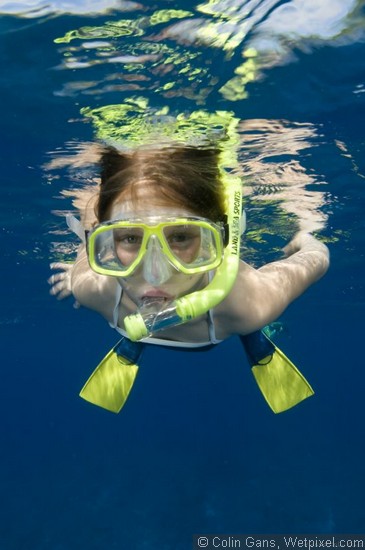Sealux CD300 underwater housing for Nikon D300 review
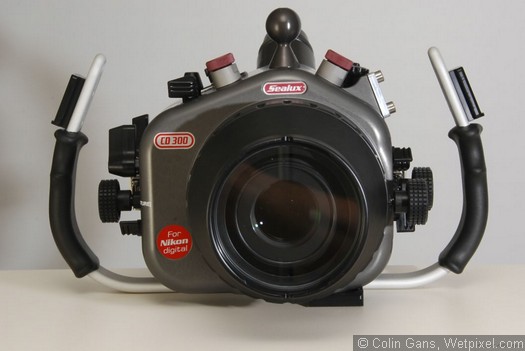
Mastering the operation of an underwater housing is a journey of familiarization. You move through a process of engaging its functionality, employing its ergonomics and adapting to its idiosyncrasies and so become at one with it; through lots of practice. It’s like learning to play an instrument.
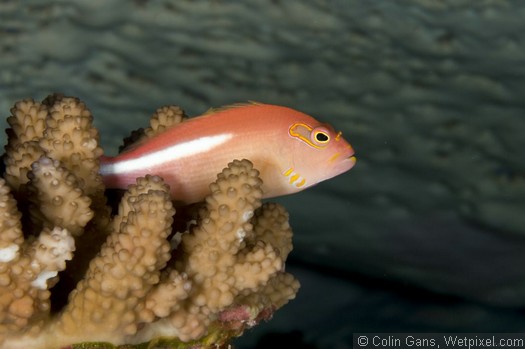
Sealux’s CD300 housing for the Nikon D300 DSLR has a similar feel to the earlier D200 housing only with improvements in performance and functionality. All the controls just seem right and the changes I have so far encountered are for the better.
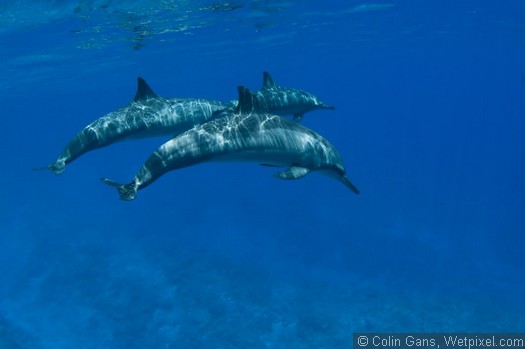
The Nikon D300 Camera in Brief
Key improvements with the D300 camera over the D200 which I have found to be useful in a practical context for underwater photography are:
- excellent monitor resolution and response, enabling effective in-camera decision making while underwater;
- the ability to view camera settings, previously only visible in the top LCD window, in a large clear format in the monitor window;
- improved image quality (if nothing else, this allows for more leeway with cropping);
- significantly longer battery life;
- slightly increased dynamic range with 14 bit RAW images;
- slightly less noise at higher ISO levels;
- self cleaning image sensor;
- Nikon D2X plus-some in a compact D200 style body.
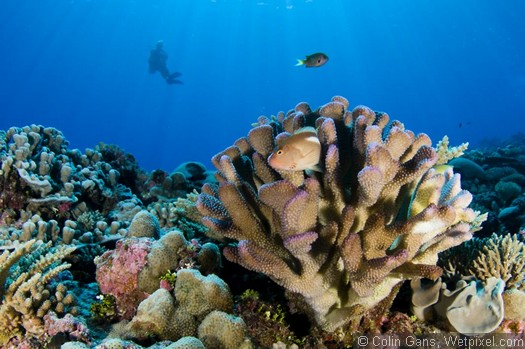
Improvements and Features of the CD300 Housing
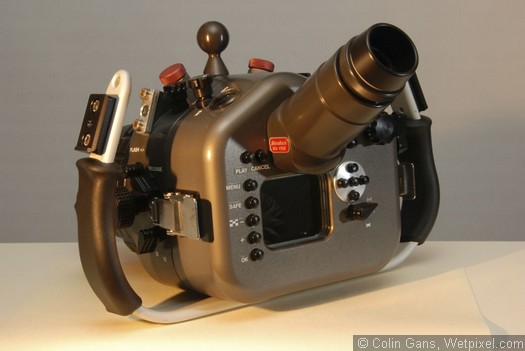
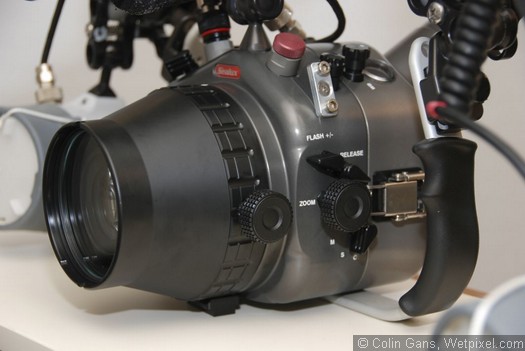
Whilst my previous two Sealux housings were functional and durable (see my site for reviews) the CD300 shows an improvement in aesthetics and ergonomics with the introduction of some subtle changes including: curved handles and conically tapered flat ports for close-up and macro work.
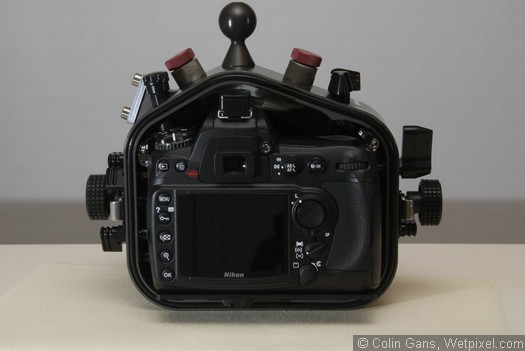
A feature on Sealux housings which I think is a good design attribute is the raised inner lip on the housing body which stops water falling back into the housing when the housing back is removed after a dive. This also serves as a guide to placement of the lid on the housing body for sealed closure.
Attention to detail is evident in the design of the CD300. Mineral glass rather than polycarbonate is used for the window over the D300 monitor display and this does justice to the resolution and clarity of the D300’s display. This is an important feature and one which rated highly in my deciding whether to purchase. The monitor window is visible with the 150 degree viewfinder rotated to any of its selectable positions. As with other Sealux DSLR housings, tested depth rating is given as 90 metres.
The CD300 allows for an additional ball mount to be installed in the threaded socket provided on the centre top of the housing to mount a focus light or other accessory. This effectively gives four possible mounting points on the housing for strobes and accessories; one on each arm, a third one on the left hand side and the ball mount at centre top. Two different size ball fittings are available. The additional ball mount can be unscrewed to allow the housing to fit in my cabin bag without the ball protruding.
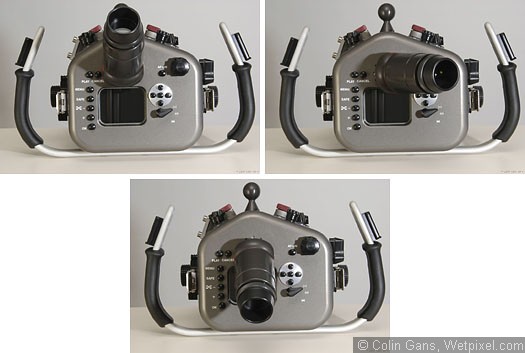
My CD300 sports the new 150 degree optical viewfinder (GV150). Sealux viewfinders have in the past been very successful and this one appears to be no exception. The prism model GD Viewfinder made by Sealux is also on-sold to Subal for their underwater housings. The GV150 viewfinder provides an enlarged 150 degree view which is bright, sharp and complete; it rotates to allow portrait and landscape views and is useful for over-under images. A detachable sunshield is fitted to the eyepiece. The viewfinder can be turned downwards when transporting or removed by hand by disengaging the plastic circlip on the inside of the housing cover. Dual o-rings on the viewfinder shaft provide a watertight fit onto the housing. I found the GV150 to be as good as the GD Viewfinder in coverage and clarity with the added advantage of being angled and able to rotate.
The housing is made of aluminium milled monoblock CNC, hard anodized and is sealed for resistance to saltwater corrosion. The colour, described as titanium grey, is a little darker than my earlier D200 housing. The controls appear to feel better but whether this is a case of ‘new broom’ syndrome or not, time will tell.
The Controls
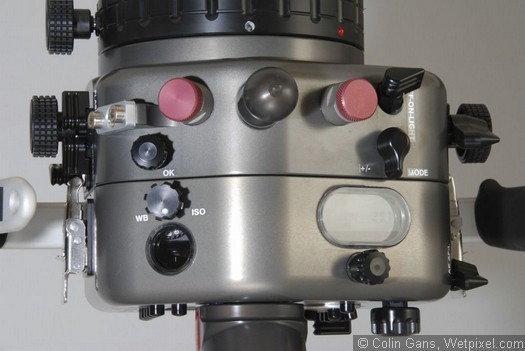
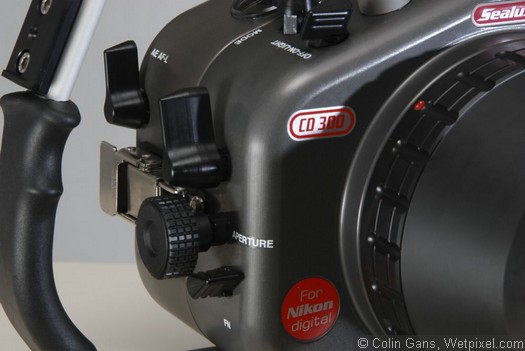
One improvement which is welcomed is a change in design to the previously quirky focus mode control which switches between continuous, single, or manual focus (C/S/M) modes. This has been re-engineered and works very well with a good tactile feel when switching. Some controls described below are available optional extras. I suggest visiting the Sealux website for current details on options.
Live View Release Mode Dial
The release mode dial which allows control of Live View, Single Frame, Continuous, Self Timer and Mirror Up is engineered as a single control; a clever solution. When engaged it depresses the locking button while rotating the dial on the camera. I would be interested to see how other housing manufacturers’ solve this.
Focus Priority Override
The AF Lock lever is well positioned to be used in conjunction with the shutter release lever to override focus priority. This is handy for lenses like the Nikon 105VR micro when used with the focus gear as it allows focus priority to be overridden on demand simply by squeezing the AF Lock lever with the thumb while operating the shutter release with the forefinger; a perfectly natural movement.
A Centre Multi Selector Button
Some underwater housings I have tried lack the centre control for the camera’s multi selector. Sealux have provided access to the centre button by engineering four of the shafts at slight angles allowing the buttons to be spread a little further apart on the outside. The five controls (North, South, West, East and Centre) are symmetrically placed. I found the response of the multi-selector quite sensitive but after a day or so of using the housing I have now become used to this.
The Flash Mode Button
The Flash mode button is another challenging control to engineer due to its position on the camera. This button is controlled via a lever and is well situated for access to enable switching between normal flash mode and rear curtain sync as well as flash compensation when using a housed speedlight.
The Mode and +/- Control
Both the mode and +/- buttons on the camera are controlled by a single lever, neither of which are engaged when the lever is in centre position. Pushing the lever to the left engages +/- exposure compensation. Pushing the lever to the right engages camera mode. In either engaged position the respective button stays down until the lever is returned to the centre position. In practice I have found this to be useful since both of the underlying buttons work in conjunction with the front command dial which needs to be rotated. Having these buttons stay down until disengaged allows the front command dial to be operated with thumb and forefinger.
Func Button Control
A Func button control lever allows the D300’s user-defined function button to be accessed. With the D200, I viewed this as a ‘nice to have’. Now that its available I’ve had to think what I’ll use it for. I have since decided that assigning the Func button to ‘Flash Off’ is a good choice. There have been times when I’ve wished for a convenient way of cancelling flash without taking my eye off the viewfinder and this approach works very well. I can override the flash to do an ambient light shot with my ring finger, override autofocus with my thumb and press the shutter with my forefinger; feels like I’m playing a saxophone! This is certainly more convenient than having to manually switch off strobes. The location and feel of each of these three levers is ergonomically good.
Lens Release Lever
A lens release lever in the housing body allows the easy removal of lenses from the front port. This is handy when switching lenses between dives. Prior to using this control I had placed it in the ‘nice to have’ basket of features. Now that it is available I’m finding that I use it more frequently than expected.
QUALity, ISO and WhiteBalance
While the more important WB and ISO button controls are available, there is no direct control button for the third member of the trio, the QUAL button. This control can be set as a shortcut and then accessed by pressing the Menu button. In my opinion having a QUAL button is not missed as it’s not often that I would choose to switch image quality and should I wish to do so then ‘My Menu’ is sufficiently convenient for the job.
The Lens Port System
Sealux ports use glass and I do like their dependable design. They have a large diameter bayonet fitting with good o’ring seals making for a reliable seal. I have used the housing with a dome port, towed next to a boat, photographing spinner dolphin and have experienced no leaks despite such turbulent motion at shallow depth. The port system is modular and allows the use of extension rings to allow match ports to be used with a wider range of lenses. All port windows are high quality optical glass. Barrels are made of Delrin. The ports are durable, well designed and I have yet to experience a leak from either port or housing body in hundreds of dives over a four year period. The effort experienced in changing ports can be reduced with the use of a lightweight strap wrench as described in the ‘Niggles’ section. The tight and positive bayonet fit of the Sealux ports may in fact contribute to their very low flood rate; it would not be easy to open a lens port underwater.
Port extension rings allow a modular approach and the same rings can be used on flat and dome ports to cater for most popular lenses. Since the same tried and tested bayonet fittings have been used for many years, there is protection of existing investment and as we know, our lasting investment is more in the glass (lenses and ports) than the ever changing cameras and housings which fit them.
The large optical dome port (180F) has been available for some time and is excellent for 10.5mm Nikon, 10-17mm Tokina and also the 12-24mm Nikon with the addition of an extension ring. What’s new is the PS series of flat ports which are conically tapered from about 126mm at the housing side down to approximately 92mm at the glass end. The tapering allows better positioning of strobes for macro work and has a more aesthetically pleasing look.
In addition to this, Sealux have come out with a series of good quality wetmate diopters for the new flat ports which fit neatly onto the front of the ports with a bayonet type lock. I ordered one of these on a whim and am very impressed with how well it fits on the port. The diopter works with both the 60mm and 105mm micro lenses.
The following are examples of port options for popular lenses for underwater photography:
- Nikon 10.5mm fisheye: 180F Dome Port
- Tokina 10-17 fisheye zoom: 180F Dome Port
- Nikon 12-24mm: 180F Dome Port + 28mm extension ring
- Nikon 60mm micro: PS104
- Nikon 105mm micro (both VR and classic): either PS114; or PS 104+ 28mm extension ring with manual focus gear option available either in the port or in the extension ring if this latter combination is chosen.
Strobe Wiring and Bulkhead Options
Strobe ports are available in three forms, Nikonos style flexible pin, Nikonos style all pins fixed, or S6. Either one or two strobe ports can be ordered in various combinations.
The strobe bulkhead wiring allows choice of TTL (5 pins active) wiring or just two pins active for traditional strobes and these can be changed at a later stage by ordering a different wiring configuration. Having all 5 pins wired allows use of a single housed SB800 to be electrically connected as well as third party TTL adapters such as Ikelite’s #4302. Careful thought should be given to the choice of ports and wiring. My personal choice is for two Nikonos style flexible pin ports with all five pins active as this provides wired connections for either a single housed speedlight or two Ikelite DS125 strobes.
I chose two Nikonos style strobe bulkheads. The Nikonos bulkheads are offered in two flavours, the traditional with two flexible / three fixed pins and the other form with all five pins fixed. Whichever flavour is chosen the option exists to order either as TTL capable with all five pins wired or just the two GND and TRG active, i.e. wired. From past experience I have found switching wiring on Sealux housings to be a relatively straightforward exercise once the strobe logic is understood.
Niggles
Whilst this review is for the most part positive there are two niggles, still present, which I have experienced with earlier housings. The first relates to the degree of effort involved in changing ports; yes, unnecessary physical effort! The second issue arose with the D200 housing as a symptom of downsizing in the drive to keep things compact. The D200 and D300 housings became more negatively buoyant with these cameras which were heavier than the similar sized D70. Effective workarounds exist for both of these issues and I do not see them as detracting from the overall qualities of the housing once the workarounds are applied. Each particular brand of housing has its quirks and after all, where would the challenge lie in underwater photography without having to problem solve?
I previously found switching ports on dive trips to be tedious with some effort required, to coerce the installed port off the housing. Enter the ‘Baby Boa strap wrench’, a lightweight plastic strap wrench perfect for the job of removing ports by gripping the barrel and allowing sufficient leverage to be applied. It would be useful to have these, or similar supplied with Sealux ports. The strap wrench has made changing ports easy for me and can be found in many hardware stores or you can try online using ‘strap wrench’ for your search.
The issue of a negatively buoyant housing should only be of concern for macro photography and I have found that using Stix buoyancy arms with my two Ikelite DS125 strobes resolves this neatly. I use four of the SX-109 sets and UCLS butterfly clamps to hold them.
With this setup and the heaviest lens / port combo I own (105mm Nikon VR / PS114 port) plus focus light the rig weighs 330grams negative in fresh water.
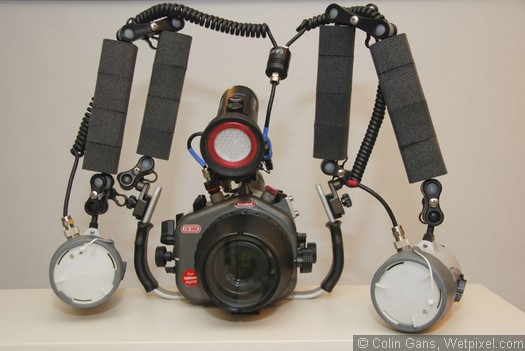
The Housing In Summary
In brief, I see the CD300 as a step forward; it has, so far, exceeded my expectations.
The good points
- Optics: the ports, the display and the 150 degree viewfinder; all precision glass optics
- Ergonomics: the location of key controls in relation to each other
- Functionality: almost every camera control one could wish for including controls for Live View, C/S/M, Func, Multi-selector centre, Flash mode, AF Lock and Lens release.
- Durability: good seals, raised inner housing lip, robust construction
- Portability: compact and relatively easy to pack and transport for a DSLR housing
- Depth rating: 90 metres (295 feet)
The niggles
- Negatively buoyant: remedied by flotation arms
- Effort in removing lens ports: remedied by using a lightweight strap wrench
Notes from the Field
For this review I tested the housing dry; in a pool and then followed up with a week of diving off Niue Island. I used 60mm, 105mm, 10-17mm and 12-24mm lenses with respective close-up port / wetmate diopter combinations and dome port plus extension ring combinations. I was happy with results from all combinations tested; particularly when using the PS close-up ports as these were new to me and showed improvement over the bulkier traditional Sealux flat ports.
Conclusion
I see the CD300 as a step forward from its predecessor with design features which are compact, aesthetically pleasing, ergonomic and durable. In forming a complete system, individual components exist for most needs and integrate well with the modular port system. Different options cater for various lighting interfaces be they a housed speedlight, Nikonos style strobe fittings or European style S6 plugs. This housing makes music - highly recommended.
